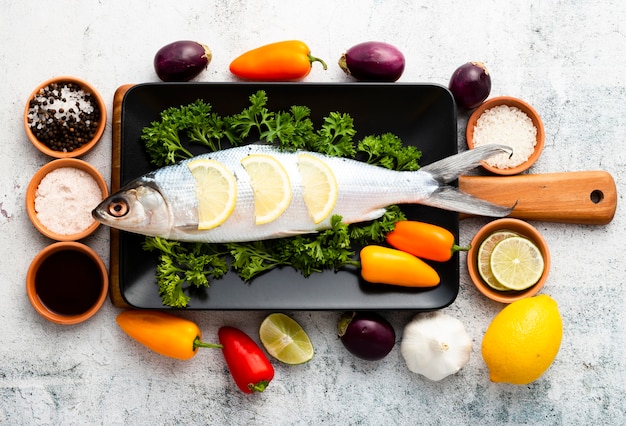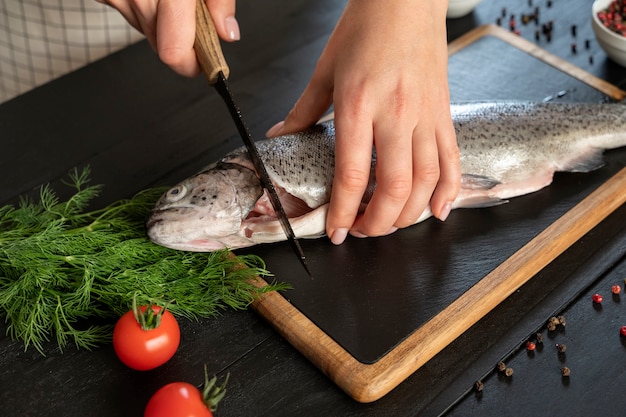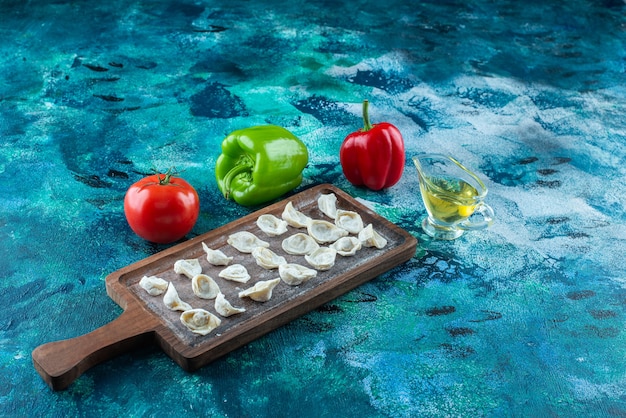Let's be honest, cooking fish can be a bit of a mystery for beginners. One minute it's perfectly flaky and juicy, and the next it's dry and crumbly. Been there, done that. I remember trying to make salmon for a date and ending up with something resembling a piece of cardboard – not my finest moment! But over time, I've learned a thing or two about fish and how to cook it properly. Now, I'm sharing all my tips and tricks with you, with a special focus on that all-important question: what's the perfect temperature for cooking fish? Let's dive in!
(Part 1) The Basics of Fish Cooking: A Foundation for Success

Before we get into the nitty-gritty of temperatures, it's important to lay a solid foundation. Understanding a few basic principles will set you up for success in the kitchen and help you avoid those unfortunate cardboard-salmon incidents.
1. Understanding Fish Types: A World of Diversity
Fish come in all shapes, sizes, and textures, each with its own personality. Some, like cod or haddock, are delicate and cook quickly, almost like melting snowflakes. Others, like tuna or swordfish, have a firmer texture and can handle a bit more heat, like a seasoned veteran. Knowing these characteristics will help you choose the right cooking method and temperature.
- Delicate fish: These beauties are often thinner and cook in a flash. Overcooking them will leave them dry and rubbery. Think of cod, haddock, sole, flounder, and trout. They're best suited for gentle cooking methods like poaching, steaming, or quick pan-frying.
- Medium-bodied fish: These are the all-rounders, the reliable friends. They hold their shape well and don't fall apart easily. Think of salmon, sea bass, and mahi-mahi. They're versatile and can be cooked in a variety of ways, from baking to grilling.
- Firm fish: These fish are the tough cookies, the ones that can handle the heat. They have a robust texture and can withstand higher temperatures without becoming dry. Think of tuna, swordfish, marlin, and shark. These guys are perfect for grilling, searing, or even grilling.
2. The Importance of Freshness: The Key to Flavor
This might seem obvious, but using fresh fish is the absolute key. The fresher the fish, the better it will taste, and the easier it will be to cook. It's like the difference between a fresh-baked loaf of bread and a week-old stale one. When buying fish from a market, keep these tips in mind:
- Look for bright, clear eyes – they're a sign of freshness.
- Check for firm flesh – it should spring back when you press it gently.
- Smell for a mild, fresh scent – avoid fish that smells fishy or strong.
- Avoid any fish that looks dull, has a fishy odor, or feels slimy – those are signs of spoilage.
3. The Right Equipment: Tools for Success
You don't need a fancy kitchen to cook fish. A good non-stick pan, a baking sheet, and a grill will do the trick. But let's be honest, the right tools can make a big difference, especially when it comes to cooking fish.
- Non-stick pan: A good non-stick pan is essential for pan-frying fish, as it prevents sticking and ensures even cooking. Look for a pan with a heavy base for even heat distribution.
- Baking sheet: A baking sheet is perfect for baking fish, especially if you're cooking multiple fillets. Choose a sheet with a rim to prevent spills.
- Grill: A grill is ideal for adding smoky flavor to fish. You can use a gas grill, charcoal grill, or even an indoor grill pan.
- Fish poacher: A fish poacher is a specialized pot designed for poaching fish. It allows for even cooking and preserves the fish's natural moisture.
- Steamer: A steamer is another great way to cook fish gently. It's a simple and healthy way to prepare fish, as it doesn't require any added oil or fat.
(Part 2) The Importance of Temperature: The Key to Perfect Fish

Now, let's get to the heart of the matter: temperature. It's the key to cooking fish that's perfectly cooked, juicy, and flavorful. Just like baking a cake, getting the temperature right is crucial to achieving the desired outcome.
1. Oven Temperature: Baking to Perfection
For oven-baked fish, the ideal temperature is typically between 350°F (175°C) and 400°F (200°C). The exact temperature will depend on the thickness of the fish and how you're preparing it. Thicker fish require a slightly lower temperature to prevent overcooking. Think of it like baking a cake – you wouldn't bake a small cupcake at the same temperature as a large cake, right?
2. Pan-Frying Temperature: Searing to Perfection
Pan-frying is another popular way to cook fish, especially for achieving a delicious crispy exterior. Here, the temperature of the oil is crucial. You want the oil to be hot enough to sear the fish and create a crispy crust, but not so hot that it burns the fish before it's cooked through. It's a delicate dance between heat and time.
Aim for a temperature of around 350°F (175°C) for medium-heat pan-frying. To test the temperature, drop a small piece of bread into the oil. If it browns quickly and bubbles vigorously, the oil is ready. If it doesn't, give the oil a few more minutes to heat up.
3. Grilling Temperature: Smoky and Delicious
Grilling fish is a fantastic way to add a smoky flavor, giving it a more robust character. When grilling, aim for a medium-high heat, typically around 400°F (200°C). This will ensure the fish cooks quickly and develops those lovely grill marks. But keep an eye on it, as it can cook very quickly, especially over a hot grill.
(Part 3) How to Tell When Fish is Cooked: Mastering the Signs

Here's where things can get a little tricky, especially for beginners. How do you know when your fish is cooked through and ready to eat? Don't worry, there are a few reliable signs to look for:
1. The “Flake Test”: A Simple Check for Doneness
This is probably the most reliable method. Gently press the fish with a fork. If the flesh flakes easily, it's cooked. If it's still firm and resists the fork, it needs more time. It's like testing a cake with a toothpick – if it comes out clean, it's done.
2. The “Opacity Test”: Observing the Transformation
As fish cooks, it will change from translucent to opaque. If the fish is still translucent in the middle, it needs more cooking time. Think of it like a raw egg white – it's clear until it cooks and becomes white and opaque.
3. The “internal temperature”: The Scientific Approach
For those who prefer a more precise method, you can use a meat thermometer to check the internal temperature of the fish. The safe internal temperature for most fish is 145°F (63°C). This ensures the fish is cooked through and safe to eat. It's like using a thermometer to make sure your cake is baked all the way through.
(Part 4) Cooking Fish: A Step-by-Step Guide to Oven-Baked Fish
Now, let's get practical! Here's a step-by-step guide to cooking fish in the oven, a simple and reliable method:
1. Preheat Your Oven: Setting the Stage
Set your oven to the desired temperature, typically between 350°F (175°C) and 400°F (200°C), depending on the thickness of your fish. This allows the oven to reach the correct temperature for even cooking.
2. Prepare the Fish: The Art of Seasoning
Pat the fish dry with paper towels. This helps to prevent sticking and ensures a crispy crust. Season it with salt, pepper, and any other desired herbs or spices. You can get creative with your seasoning. Try lemon zest and dill for a classic flavor, or garlic powder and paprika for a more savory kick. If you're using a marinade, let the fish marinate for at least 30 minutes, allowing the flavors to penetrate deeply.
3. Place the Fish on a Baking Sheet: A Bed for Your Fish
Line a baking sheet with parchment paper or foil for easy cleanup. Place the fish on the baking sheet, making sure to leave some space between each piece. This ensures even cooking and prevents the fish from steaming rather than baking.
4. Bake the Fish: The Transformation Begins
Bake the fish for 10-15 minutes, or until the internal temperature reaches 145°F (63°C). The exact cooking time will depend on the thickness of the fish. Keep an eye on it and check for doneness using the “flake test” or a meat thermometer. It's like watching a pot of water boil – you need to keep an eye on it to ensure it doesn't overcook.
5. Rest and Serve: Letting the Fish Breathe
Once the fish is cooked, remove it from the oven and let it rest for a few minutes before serving. This allows the fish to continue cooking slightly and prevents the juices from running out. It's like letting a cake cool before slicing – it helps it to firm up and retain its moisture.
(Part 5) How to Avoid Overcooking Fish: The Art of Timing
Overcooked fish is a common mistake, but it's easily avoided with a little care and attention. Here are a few tips:
- Don’t overcrowd the pan or baking sheet. Give the fish some space to cook evenly. It's like baking cookies – overcrowding the sheet will lead to uneven browning.
- Use a timer. Set a timer to remind you to check the fish for doneness. This will help you avoid those accidental overcooked fish disasters.
- Don’t flip the fish too often. Only flip the fish once, halfway through cooking. Flipping it too often can dry it out. It's like flipping a pancake – too many flips can make it dry and tough.
(Part 6) Cooking Fish: Recipe Ideas to Ignite Your Creativity
Now that you've got the basics down, let's get cooking! Here are some delicious fish recipes to get you started, sparking your culinary imagination:
1. Baked salmon with lemon and Dill: A Classic Delight
This recipe is a true classic for a reason – it's simple, flavorful, and incredibly satisfying.
Ingredients:
- 1 pound salmon fillet, skin on or off
- 1 tablespoon olive oil
- 1 lemon, thinly sliced
- 2 tablespoons fresh dill, chopped
- Salt and pepper to taste
- Preheat oven to 375°F (190°C).
- Place the salmon fillet on a baking sheet lined with parchment paper.
- Drizzle the salmon with olive oil and season with salt and pepper.
- Top the salmon with lemon slices and dill.
- Bake for 12-15 minutes, or until the salmon is cooked through. You can tell it's done when the flesh flakes easily with a fork.
2. Pan-Seared Cod with Garlic and Herbs: A Burst of Flavor
This recipe is a quick and easy way to cook cod, creating a delicious and flavorful meal in minutes.
Ingredients:
- 1 pound cod fillets
- 2 tablespoons olive oil
- 2 cloves garlic, minced
- 1 tablespoon fresh parsley, chopped
- 1 teaspoon lemon zest
- Salt and pepper to taste
- Heat the olive oil in a non-stick pan over medium-high heat. You want the oil to be hot enough to sear the fish but not so hot that it burns.
- Season the cod fillets with salt and pepper. Don't be afraid to season generously!
- Place the cod fillets in the hot pan and cook for 3-4 minutes per side, or until golden brown and cooked through. Be sure to check for doneness using the flake test.
- Remove the cod fillets from the pan and set aside.
- Add the minced garlic to the pan and cook for 30 seconds, or until fragrant. This will infuse the pan with delicious garlic flavor.
- Stir in the parsley and lemon zest. The lemon zest adds a bright, refreshing touch.
- Pour the garlic herb sauce over the cooked cod fillets and serve. This creates a beautiful presentation and brings everything together.
(Part 7) Fish Storage and Leftovers: Making the Most of Your Creations
Once you've cooked your fish masterpiece, it's important to store it properly. Here are some guidelines:
1. Storage: Keeping Fish Fresh
If you have leftover cooked fish, refrigerate it promptly. Store it in an airtight container in the refrigerator for up to 3 days. This will prevent the fish from drying out or absorbing flavors from other foods in your refrigerator.
2. Reheating: Restoring Flavor
When you're ready to enjoy those leftovers, you can reheat them in the oven, microwave, or pan. If you're using the oven, preheat it to 350°F (175°C) and bake the fish for 5-10 minutes. If you're using the microwave, heat the fish on low for 1-2 minutes, or until warmed through. You can also add a little bit of lemon juice or a splash of broth to help keep the fish moist during reheating.
(Part 8) FAQs: Addressing Common Questions
Here are some commonly asked questions about cooking fish, providing a guide for those seeking answers.
1. What’s the best way to remove fish bones?
A good quality fish fillet should be boneless, but sometimes you might find a stray bone or two. Use a pair of tweezers to remove any bones you find. If you're dealing with a whole fish, you can ask your fishmonger to fillet it for you, or you can find instructions online on how to fillet a fish. It's a skill worth learning, as it can save you money and give you a greater appreciation for the fish you eat.
2. Can I overcook fish if I bake it in foil?
Baking fish in foil helps to keep it moist, but it can still be overcooked if you leave it in the oven for too long. Make sure to check the fish for doneness using the “flake test” or a meat thermometer. You can also remove the fish from the oven a few minutes early to avoid overcooking. It's better to err on the side of caution and check early than to risk overcooking.
3. Can I freeze fish?
Yes, you can freeze fish. To freeze fish, wrap it tightly in plastic wrap or aluminum foil, then place it in a freezer bag. Fish can be frozen for up to 3 months. Make sure to thaw the fish completely in the refrigerator before cooking. This will prevent the fish from being cooked unevenly.
4. What if my fish is too salty?
If you find that your fish is too salty, you can try to balance out the flavor by adding a squeeze of lemon juice, a sprinkle of sugar, or a dollop of sour cream or yogurt. You can also soak the fish in milk or water for 30 minutes to help remove some of the salt. Sometimes a little bit of sweetness or acidity can counteract saltiness.
5. How can I make fish more flavorful?
There are many ways to enhance the flavor of fish. You can marinate it in citrus juices, herbs, spices, or soy sauce. You can also add flavor by serving it with sauces, like a lemon butter sauce, a creamy pesto sauce, or a spicy tomato sauce. Don't be afraid to experiment with different flavors until you find what you enjoy.
I hope this guide helps you to conquer the art of cooking fish. Remember, the key is to start with fresh fish, choose the right cooking method, and pay attention to the doneness. Don't be afraid to experiment and have fun in the kitchen. Happy cooking!
Everyone is watching

Corn on the Cob: The Ultimate Guide to Perfectly Cooked Ears
Healthy MealsAh, corn on the cob. Just the name evokes images of sunny days, barbecues, and that sweet, juicy flavour that ...

Perfect Pork Roast Oven Cooking Time: A Guide to Delicious Results
Healthy MealsThere's something truly satisfying about a perfectly roasted pork. The aroma alone is enough to make your mout...

Ham Cooking Time: How Long to Bake, Smoke, or Boil a Delicious Ham
Healthy MealsAh, ham. It's a classic, isn't it? A real crowd-pleaser, especially around holidays. And when done right, it'...

Scallops: The Ultimate Guide to Perfect Cooking
Healthy MealsAh, scallops. Those delicate, sweet, and utterly delicious morsels of the sea. They hold a special place in my...

Spaghetti Squash: The Ultimate Guide to Cooking and Serving
Healthy MealsRemember that time you saw spaghetti squash at the supermarket, looking all bumpy and strange, and thought, "W...
